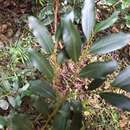fi
nimet breadcrumb-navigoinnissa


Diospyros australis is the most southerly of the group of some 450 ebonies and persimmons. It is a shrub or small tree growing in rainforests of seaward eastern Australia. The habitat is in a variety of different rainforest forms, though not often seen in the cool temperate rainforests. The range of natural distribution is from Durras Lake (35° S) near Batemans Bay in south east New South Wales, to Atherton (17° S) in tropical Queensland.
Common names include black plum and yellow persimmon. "Grey plum", sometimes used for this species, usually denotes its northern relative D. pentamera.
Junior synonyms of D. australis are:

An attractive small tree, rarely reaching a height of 20 metres and a trunk diameter of 25 cm (10 in). The yellow tinged foliage and black berries make identification relatively easy.
The base of the tree is not flanged or buttressed. Bark on the cylindrical trunk is grey or black, with wrinkles, bumps and lines. Leaves are yellow or yellow-green underneath with a prominent yellow mid vein. Leaves alternate, smooth edged, elliptical or oblong 4 to 10 cm (4 in) long. Leaf stalks 2 to 5 mm long.
Flowers appear between October and December, being creamy green and four petalled. Female flowers being larger than male flowers.
The fruit matures in the months of February to July, being a shiny black berry, elliptical in shape, 12 to 20 mm in length. Around the base of the berry is a four or sometimes five lobed green calyx. A single seed is in each fruit, surrounded by edible purple aril. The 1889 book 'The Useful Native Plants of Australia records that Indigenous people of the Illawarra area also referred to the plant as "Booreerra" and was source of food.[1]
Germination from fresh seed is slow, but reliable. After three months, the majority of seeds should germinate.
Its edible berries are used in bushfood.
Diospyros australis is the most southerly of the group of some 450 ebonies and persimmons. It is a shrub or small tree growing in rainforests of seaward eastern Australia. The habitat is in a variety of different rainforest forms, though not often seen in the cool temperate rainforests. The range of natural distribution is from Durras Lake (35° S) near Batemans Bay in south east New South Wales, to Atherton (17° S) in tropical Queensland.
Common names include black plum and yellow persimmon. "Grey plum", sometimes used for this species, usually denotes its northern relative D. pentamera.
Junior synonyms of D. australis are:
Cargillia australis R.Br. Diospyros cargillia F.Muell. Diospyros microcarpa Gürke Maba cargilia F.Muell.Diospyros australis es el más austral de los 450 ébanos y persimones.
Es un arbusto o árbol pequeño que crece en el bosque lluvioso del este de Australia. El hábitat es una variedad de diferentes formaciones de selvas y bosques húmedos, sin embargo no se le ve con frecuencia en los bosques frescos. El rango de su distribución natural es desde Durras Lake (35° S) cerca de Batemans Bay en el sureste de Nueva Gales del Sur, hasta la localidad de Atherton (17° S) en el trópico de Queensland.
Nombres comunes incluyen ciruelo negro (black plum), persimón amarillo (yellow persimmon) y ciruelo gris (grey plum)
Es un árbol pequeño atractivo, raramente alcanza una altura de 20 metros y un diámetro en el tronco de 25 cm. El follaje teñido de amarillo y las bayas negras hacen su identificación relativamente fácil.
La base del árbol no está rebordeada ni ensanchada. La corteza en el tronco cilíndrico es gris o negruzca, con arrugas, abolladuras y líneas. Las hojas son amarillas o verde amarillentas en el envés con una prominente vena central. Las hojas son alternadas, lisas, con los bordes lisos, elípticas u oblongas de 4 a 10 cm de largo. Los tallos de las hojas miden de 2 a 5 mm de largo.
Las flores aparecen entre octubre y diciembre, siendo de color verde cremoso y teniendo 4 pétalos. Las flores femeninas son más grandes que las masculinas.
El fruto madura entre los meses de febrero a julio, siendo una baya negra brillosa elíptica, de 12 a 20 mm de largo. Alrededor de la base de baya hay cuatro o veces cinco sépalos verdes lobulados. Hay una sola semilla en cada fruto, rodeada por un arilo comestible rosa.
La germinación de la semilla fresca es lenta pero confiable. Después de tres meses, la mayoría de las semillas deben germinar.
Las bayas son comestibles.
Diospyros australis fue descrita por (R.Br.) Hiern y publicado en Transactions of the Cambridge Philosophical Society 12: 54. 1873.[1]
Diospyros: nombre genérico que proviene de (διόσπυρον) del griego Διός "de Zeus" y πυρός "grano", "trigo" por lo que significa originalmente "grano o fruto de Zeus". Los autores de la antigüedad usaron el vocablo con sentidos diversos: Teofrasto menciona un diósp¯yros –un árbol con pequeños frutos comestibles de huesecillo duro–, el que según parece es el almez (Celtis australis L., ulmáceas), y Plinio el Viejo (27.98) y Dioscórides lo usaron como otro nombre del griego lithóspermon, de líthos = piedra y spérma = simiente, semilla, y que habitualmente se identifica con el Lithospermum officinale L. (boragináceas). Linneo tomó el nombre genérico de Dalechamps, quien llamó al Diospyros lotus "Diospyros sive Faba Graeca, latifolia".[2][3]
australis: epíteto geográfico que alude a su localización en el sur.[4]
Diospyros australis là một loài thực vật có hoa trong họ Thị. Loài này được (R.Br.) Hiern mô tả khoa học đầu tiên năm 1873.[1]
Diospyros australis là một loài thực vật có hoa trong họ Thị. Loài này được (R.Br.) Hiern mô tả khoa học đầu tiên năm 1873.